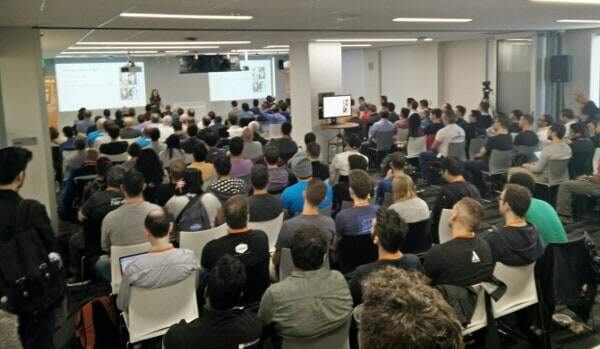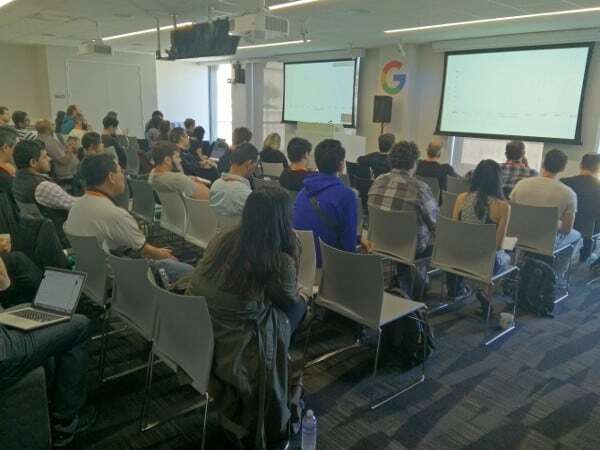Kranky Geek 2017 has been a roller coaster event for me. Time to discuss what I learned about the WebRTC last week.

Yap. We had a full room.

Well… More like 2 full rooms.
When talking to Lawrence some time in the afternoon, he joked with me, saying that apparently we have a problem – the overflow room is overflowing.
The best problem an event organizer could ever ask for.
If you are looking for the event videos, then they are already on YouTube.
I want to share some of my thoughts prior to the event and during to the event. And if possible, try and shed some light on where we’re headed from here.
Challenges Abound
Putting up an event is a stressful undertaking. There are a lot of aspects that needs to be covered with this constant worry that you’ll end up forgetting something or that something will screw you over. Both are guaranteed to happen no matter how much planning and effort you put into it.
This time, our challenges started early on. It was somewhat harder than usual to decide how to price the event to make it worthwhile doing. Kranky Geek events are expensive to run. From the beginning, we’ve aimed for events that are free to attend (I consider a $10 admission fee that gets donated as a free to attend event). This left us with covering our expenses and making some revenue out of it something that relies on sponsors.
Kranky Geek is all about quality content. High quality content. Top notch. The best you can find.
Which means that we select the topics we want. We then hunt for the speakers that fit into that. And we work with our speakers to make them shine.
This process doesn’t always work with sponsors… it is sometimes hard to explain how we operate and why. And at times, sponsors can focus on hard selling their warez, which doesn’t fit into the Kranky Geek spirit (and definitely not to our audience).
This time, it took us slightly longer than usual to get the sponsors onboard and to be certain that we can pull off the event.
It also caused some more stress than usual among us partners. Kranky Geek is a joint effort of 3 people: Chris Koehncke (aka Chris Kranky), Chad Hart (the living spirit behind webrtcHacks) and me.
We don’t always agree, but somehow we fit well together, each one covering the other one’s shortcomings. We make a good team for getting these events done. I hope 🙂
Why am I sharing all this?
To set the stage to what comes next for Kranky Geek, but also to explain the amount of work, effort,time, stress, pain and love that has been put into the Kranky Geek events in general and to this one in particular.
It hasn’t been all happy, but I am proud of the result and happy that we did this.
We Had a Fire Drill!
During the day, we’ve had our share of technical challenges.
The projectors in the main room didn’t work at the beginning (that was before we started the day), and then a few other issues cropped up on us.
Doing this event in Google’s San Francisco office meant we had the best A/V team in the world on site to help us. The crew Google is working with there is top notch. The best I worked with. They made the problems seem easy to solve.
We had this to deal with…
Great @KrankyGeek schedule at #webrtclive this year includes exercise and fresh air, with @Google providing simulated earthquakes & flames! pic.twitter.com/r0QHATG5Wj
— Lawrence Byrd (@LawrenceByrd) October 27, 2017
A week before the event we were told we will have a fire drill in the building on the day of the event. The time kept moving around, settling at 2pm. We’ve scheduled our breaks and sessions around it, with a huge worry of having people leave once the fire drill started.

(that’s Kranky going down the staircase during the drill)
We decided to embrace the fire drill and tried to celebrate it with our audience, and I hope we succeeded. Back from the fire drill, we had almost everyone back.
We should probably make fire drills an integral part of Kranky Geek events.
Time to stop rambling.
The Event Recordings
The recordings are available online.
You can find them here.
We’ve had to reorder the sessions from our original agenda due to constraints we had with some of our speakers – late arrivals and early exits.
So I’ve reordered the sessions here. Following this, are the 13 sessions we had, in the original order we wanted (not that it really mattered).
I added some of my commentary on what I liked and learned in each of the sessions.
Kranky Geek Team
Nothing to say here really, besides the fact that I envy Chad’s ability to create slides and present them.
This is the first time we had Facebook join us and share a story at Kranky Geek. We had the pleasure to have Li-Tal Mashiach an Engineering Manager at Facebook do the talk.
The numbers there are impressive as hell. 400 million monthly active users doing voice and video calls on Facebook Messenger using WebRTC. 400 million.
The next one who asks me if WebRTC is being adopted – I’ll just say 400 million. And then he’ll complain that this isn’t an enterprise application…
Anyways, what I found really interesting is how Facebook is dealing with optimization. The effort placed in the decision making process around video codecs, bitrates, etc.
WebRTC comes in a neat open source package that anyone can use. But it needs a lot more love and care when it comes to making it work at scale – just like any other technology.
TokBox
Badri Rajasekar, CTO of TokBox, shared an experiment that TokBox has been running recently. It was about using head tracking technology to improve video quality.
The idea behind it is that you can scale up a region of interest in an image sacrificing other regions, which ends up putting more pixels encoded for these regions.
The great thing here, that you do it without touching the encoder or the decoder. Why do we want that? Because the more generic you can make an encoder, the easier it is to implement it in hardware.
VoiceBase
Walter Bachtiger, Co-founder and CEO of VoiceBase talked about NLP (Natural Language Processing), and how great insights can be derived out of voice.
It was a bit of creepy, understanding how accurate machine learning can be at scale in a contact center.
The part I liked best in this one was how a contact center can decide within 30 seconds how likely you are to buy – if only the people who call me would have used it… it would have saved me a lot of time as a customer.
Atlassian
Emil Ivov, Chief Video Architect at Atlassian, and a serial speaker at Kranky Geek gave a very interesting talk about machine learning and bandwidth estimation.
The team at Jitsi now use Tensor Flow to sift through metadata they have of calls to try and understand how the network behaves and what strategy would work best in improving network quality.
It seems like reducing bitrate doesn’t always have the necessary effect on things, and FEC might end up working better.
Vidyo
Roi Sasson, CTO of Vidyo, talked about scale.
This wasn’t about how to scale a service, but rather how to scale a single call. Want 10 people on a call? You may not need to worry, but if you go to a 100 or a 1,000 – you need to think differently about it.
Which is where taking SFUs and cascading them, both within a single data center and geographically, starts making a lot of sense.
WebKit
For the first time, we had a representative from Safari. We got to hear what Apple’s default browser does with WebRTC and how from Youenn Fablet, a contributor to WebKit.
It was great to have WebKit join us at Kranky Geek, and to hear their fresh thinking about privacy in WebRTC and how they’ve taken care of that in Safari.
Peer5
Hadar Weiss, Co-founder and CEO of Peer5 talked about P2P CDN and using the WebRTC data channel.
We never did have a focused talk at the data channel in Kranky Geek, so this was a first.
I found really interesting how Peer5 does things differently than the rest of the WebRTC community. Mostly because they care less about call setup times and TURN connectivity and a lot more about throughput.
Hadar showed a few techniques I really liked, like the simple compression of SDP messages (which starts to make sense when you process and send millions of these a day).
Slack
From Slack we had Lynsey Haynes and Andrew MacDonald.
Two things interesting about this session:
- The shift they made from a custom WebRTC implementation towards the use of Electron with a vinyl WebRTC implementation in Chromium – all due to maintenance costs
- Switching from a custom Janus media server towards a self developed one written in Elixir
During the Q&A (which didn’t make it to the recording), Slack were asked about their support of Firefox. Andrew answered that support for Firefox is unlikely to come due to the shift of Slack towards focusing on less browsers and on their Electron-based desktop application. I see this thought process taking place elsewhere as well – it doesn’t bode well to the future of browsers.
Twilio
Rob Brazier from Twilio showed an AR (Augmented Reality) use case.
I’ve never been a fan of these acronyms such as IOT, AR, VR. Marrying them with WebRTC always seemed to me somewhat forced.
That said, Rob did a great job in making a case for AR in communication interactions. I am sure more exist.
Frozen Mountain
Anton Venema, CTO of Frozen Mountain was there to give an interesting demo.
He cobbled up text to speech, translation and speech to text to their media server platform, doing a demo of live language translation taking place in a WebRTC session.
Niklas Blum, Huib Kleinhout and Justin Uberti from Google shared the progress made in WebRTC towards WebRTC 1.0.
This one had a lot of details for developers about things they need to know with the latest versions of Chrome and what to prepare for moving forward.
Appear.in
This year’s closing session was given by Philipp Hancke of appear.in. He’s a repeat speaker at Kranky Geek.
Philipp delved into NSFW (Not Safe For Work) related technologies, experimenting with recognizing such content and deciding what to do with it.
It was an interesting mix of technologies, human behavior and compromises.
Our Event Sponsors
Did I already say that Kranky Geek relies of its sponsors?
This year we had 6 of them:
- TokBox
- Twilio
- Vidyo
- Frozen Mountain
- VoiceBase
I’d like to again thank our sponsors.
Diversity and Kranky Geek
We had female speakers. Great female speakers. We only managed to get a female speaker once in the past.
I want more of this.
If you are a woman, or know of a woman. One that has technical WebRTC chops. And a desire to share your experiences. Contact me…
What’s Next for Kranky Geek?
We weren’t sure if we will have another Krank Geek event. But due to the success of the one we just had, there’s high probability that we will do another one next year.
So…
Get ready for Kranky Geek 2018.
With more great content, and maybe – a fire drill.
And while at it, if you increase your visibility in the market, know that sponsoring a Kranky Geek is a great way to go about it. So put some budget aside for it. Q3/Q4 2018 is where it will take place.

Awesome videos! Thanks for all the time & effort in putting this to together Tsahi @ team!